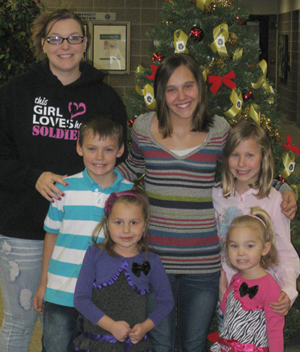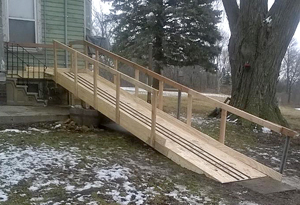By Rich Kemp

District 2 Public Affairs Coordinator TJ Melcher’s family visited the district headquarters office in Bemidji to receive gifts from District 2 employees. From left: Melcher’s wife Misti and children Tierney, Lilly, Halii, Teriana, and Taygan received gifts as part of a Holiday Giving Tree the employees sponsored. Melcher is serving in Iraq with the Minnesota National Guard. Photo by Reid Baumann |
MnDOT employees around the state donated time, food, toys and money for those in need during the holiday season. Their efforts made a difference in many people’s lives during the holidays.
“These beautiful examples of generosity represent the heart and soul of the MnDOT workforce,” said Tracy Hatch, deputy commissioner, chief financial officer and chief operating officer. “Even though MnDOT employees throughout the state make a difference every day through their work, I’m inspired to see these additional ways the MnDOT family is supporting their communities and each other.”
Here’s a look at some of the efforts around the state:
District 1
Duluth employees donated toys during a drive for Toys for Tots.
District 2
District 2 had a Holiday Giving Tree to support Public Affairs Coordinator TJ Melcher, who is serving in Iraq with the Minnesota National Guard. Employees decorated a tree with ornaments that represented a gift to Melcher's family. As Christmas drew near, the family came in to have pictures taken with the tree and to receive the gifts and well wishes from Melcher's District 2 family.
District 3
St. Cloud employees donated 56 toys and $1,065 for Toys for Tots. The employees also donated 67 pounds of food to the local food shelf.

From left Dana Casey, Keven Meacham and Trudy Kordosky organized the District 4 annual Hospice potluck and charity drawing which has raised nearly $25,000 during the last two decades. Photo courtesy of Hospice of the Red River Valley |
Baxter employees donated three Santa bags full of toys and $455 cash to the Brainerd Lakes Kids for Toys. The local AFSCME Union also donated an additional $300.
District 4
The 20th Annual Hospice Charity Potluck raised $2,400 for Hospice of the Red River Valley. Since the district started hosting the event in 1995, $24,515 has been raised for Hospice. Current and former employees donate a variety of items, many of them handmade, for the potluck and charity drawing.
District 6
The annual Toys for Tots donation drive was held in Owatonna, Rochester and Winona. District 6 has collected toys for 12 years. The employees and visitors filled up the bins several times. They also collected more than $500 in cash donations.
A group of District 6 employees took vacation time Dec. 26 to build a ramp at the home of Dennis Kinsley, a MnDOT mechanic who is in hospice care in his battle with cancer. The ramp will help Kinsley’s family as they care for him.

Employees from District 6 built a ramp at the home of Dennis Kinsley, who is in hospice care in his battle with cancer. Photo courtesy of District 6 |
He’s been on the minds of many of his co-workers and they viewed it as another way to show their support and concern. Employees donated money and materials for the project and the local AFSCME union donated money. Those who helped build the ramp were Gary Waletzki, Doug Oswald, Don Oswald and Barb McWhirter.
District 7
Employees volunteered to ring the bells for the Salvation Army Red Kettle program, collected food for the Echo Food Shelf during the Mankato Headquarters Christmas potluck and participated in the State Patrol’s Toys for Tots drive.
District 8
Gene East coordinated a toy and money drive during the holiday party in Willmar for the Salvation Army’s Toys for Kids drive. They collected toys and gently used hats, gloves and coats. The cash donations totaled $180.
Central Office
Central Office employees held two fundraisers and received a donation of $500 from the Hiway Federal Credit Union. The Office of Financial Management held its third Annual Holiday Fundraiser and raised $577. With $233 of the Hiway donation added, $800 was donated to Second Harvest Heartland hunger relief organization.
Nancy Stone collected $241 in the charity collection jars that were placed around the building. With $267 of the Hiway contribution added to those funds, a total of $508 was donated to the Family Place Shelter in St. Paul.
Employees donated more than 500 hats, mittens, scarves and socks for children at Dayton’s Bluff Elementary School in St. Paul. The event was organized by the Hiwayan Club.
The commissioner’s staff donated toiletries, long underwear, hats, sock and mittens, along with $175 in cash to Simpson Housing Services. The donations helped homeless individuals and families during holidays.
Bridge Office
Oakdale employees held two events for Minneapolis Children’s Hospital. They collected non-perishable food items for patients and their families. The employees also made 70 blankets to be placed on children’s beds before they check-in.
|



